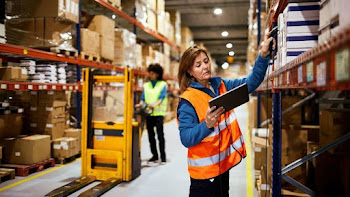What Is RTLS? A 2025 Guide to Real-Time Location Systems | AIDC
Introduction to Real-Time Location Systems (RTLS)
Real-Time Location Systems (RTLS) are advanced tracking technologies used to monitor the real-time position of assets, people, or equipment within a defined area. In 2025, these systems will be widely adopted across industries such as healthcare, logistics, manufacturing, and retail. RTLS helps businesses increase visibility, improve safety, and streamline operations by providing accurate, up-to-the-minute location data.
How Does RTLS Work in 2025?
Real-Time Location Systems work by using a network of tags, readers, and software to determine the exact location of tagged objects. The tags are attached to items or people, and they send signals to readers placed throughout a facility. These signals are processed by specialised software that maps out the position in real time.
Depending on the technology used, such as RFID, Wi-Fi, Bluetooth, or UWB, RTLS can deliver location data with varying levels of precision, from room-level to sub-meter accuracy. In 2025, advancements in sensor technologies and faster data processing have made RTLS more accurate and affordable than ever before.
Key Components of RTLS Technology
A typical Real-Time Location System includes the following core components:
-
Tags or Transmitters: Small devices attached to the asset or person to be tracked.
-
Readers or Sensors: Devices that receive signals from the tags.
-
RTLS Software Platform: Software that processes data and displays the real-time locations on a dashboard.
-
Network Infrastructure: Wireless connectivity such as Wi-Fi, Bluetooth, or proprietary protocols.
These components work together to offer seamless and automated tracking of movements and positions inside a facility.
Top Industries Using RTLS in 2025
Several industries have integrated Real-Time Location Systems into their operations to enhance efficiency and transparency:
-
Healthcare: For tracking medical equipment, patients, and staff within hospitals.
-
Logistics & Warehousing: To monitor pallets, forklifts, and inventory in real-time.
-
Manufacturing: For tracking tools, parts, and worker movement to reduce downtime.
-
Retail: To monitor shopping behaviour and prevent theft.
-
Aviation: For managing baggage and ground support equipment.
RTLS has become a key technology in smart facility management and automation across sectors.
Benefits of RTLS for Modern Businesses
Real-Time Location Systems bring several measurable advantages to businesses in 2025:
-
Increased Operational Efficiency: Real-time data helps identify and eliminate bottlenecks.
-
Enhanced Safety and Security: Ensures personnel and assets are always accounted for.
-
Asset Utilisation: Reduces loss and improves equipment usage rates.
-
Improved Customer Service: Faster service delivery and reduced waiting times.
-
Data-Driven Decisions: Enables organisations to analyse movement patterns for better planning.
These benefits make RTLS a smart investment for companies looking to stay competitive.
RTLS vs GPS: What’s the Difference?
While both RTLS and GPS provide location data, their use cases and technologies differ. GPS works well outdoors, tracking vehicles and shipments across large distances. However, it struggles indoors or in areas with weak satellite signals.
Real-Time Location Systems, on the other hand, are designed for indoor use. They provide precise tracking within buildings or campuses, making them ideal for facilities like warehouses, hospitals, and manufacturing plants. RTLS also offers better location accuracy, often within a few centimetres, depending on the setup.
Challenges and Limitations of RTLS
Despite its advantages, RTLS comes with some challenges:
-
Initial Setup Cost: Infrastructure and hardware can be expensive.
-
Complexity: Integration with existing systems may require customisation.
-
Signal Interference: Performance can be affected by metal structures or other signal-blocking materials.
-
Maintenance Needs: Tags and readers may require regular updates or replacements.
However, ongoing innovation in 2025 is helping address many of these limitations, making RTLS more scalable and user-friendly.
Real-World Applications of RTLS in 2025
Real-Time Location Systems are being applied in many ways across different sectors:
-
Patient Monitoring in Hospitals: Keeping real-time track of patients for better care.
-
Warehouse Automation: Guiding robotic systems and tracking inventory automatically.
-
Smart Offices: Managing desk booking and employee movements efficiently.
-
Event Management: Monitoring crowd flow and attendee locations for safety.
-
Airport Baggage Handling: Ensuring baggage is tracked from check-in to the carousel.
These examples reflect the growing importance of RTLS in improving everyday operations and experiences.
Future Trends in RTLS Technology
Looking ahead, several trends are shaping the future of RTLS:
-
AI Integration: Machine learning will enable predictive tracking and smarter alerts.
-
Smaller Tags: Miniaturised hardware will make RTLS suitable for even more applications.
-
5G Connectivity: Faster and more reliable communication will improve data flow.
-
Cloud-Based RTLS: Offering remote access and easier scalability for businesses.
-
Sustainability: Energy-efficient tags and infrastructure will reduce environmental impact.
These trends suggest that RTLS will continue to grow as a vital technology in smart environments.
Why Choose AIDC Technologies India for RTLS Solutions?
Your Trusted Partner in Real-Time Location Systems
AIDC Technologies India is a trusted provider of Real-Time Location Systems in the country. With years of experience in designing and implementing tailored RTLS solutions, AIDC helps businesses improve visibility, reduce manual work, and boost overall efficiency.
Whether you're in healthcare, logistics, retail, or manufacturing, AIDC offers industry-specific RTLS solutions that integrate seamlessly with your operations. From planning to installation and support, their expert team ensures smooth deployment and long-term performance.
AIDC stays at the forefront of RTLS innovation, combining hardware, software, and analytics to deliver real-time tracking with accuracy and reliability. Businesses looking for scalable and affordable RTLS systems in 2025 can rely on AIDC Technologies India for end-to-end solutions.
Book Now AIDC Technologies for Advanced RTLS Solutions
Are you ready to transform your operations with Real-Time Location Systems? AIDC Technologies India offers complete RTLS solutions tailored to your business needs. From real-time asset tracking to smart inventory management, AIDC delivers powerful tools to improve visibility, efficiency, and control.
Book now with AIDC Technologies and take your business to the next level with advanced RTLS technology built for 2025 and beyond.


Comments
Post a Comment